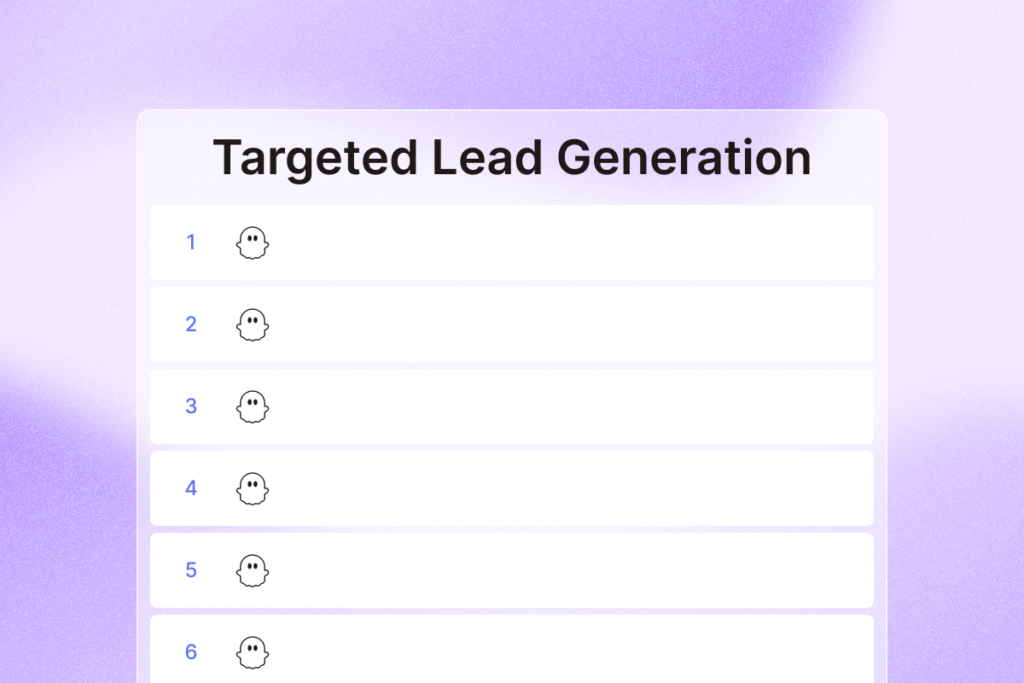Forget ‘any lead will do.’ Targeted lead generation is the laser-focused way to build a sales pipeline.
Based on gathered intelligence, it involves approaching the most likely-to-buy prospects with a targeted message.
Here’s how to build a targeted lead list.
AI highlights
- Definition of Targeted Lead Generation: Targeted lead generation is a focused approach to building a sales pipeline by identifying and engaging with prospects most likely to purchase, using tailored messages based on gathered intelligence.
- Overview of the Targeted Lead Generation Process:
- Understand Your Ideal Customer Profile (ICP): Define the characteristics of your ideal customers to focus your lead generation efforts.
- Build Your Leads Database: Use tools and platforms like LinkedIn to compile a list of potential leads that match your ICP.
- Enrich Your Lead Database: Add detailed information to your leads to prioritize and segment them into smaller, more targeted lists.
- Segment Audiences and Create Micro Lists: Refine your lead lists by using criteria like recent job changes or social media interactions.
- Sync Data with Your CRM and Automate: Integrate your lead generation activities with a CRM to ensure consistent communication from your marketing and sales teams.
- Recommended Methods for Generating Targeted Leads:
- Use Lead Scraping Tools: Extract fresh data from platforms like LinkedIn to create quality lead lists.
- Utilize LinkedIn Sales Navigator: Apply advanced filters to identify high-quality leads that align with your strategy.
- Inbound Marketing Lead Generation: Leverage lead magnets, content marketing, paid ads, and email marketing to attract and nurture leads.
- PhantomBuster’s Role: PhantomBuster automates data extraction and enrichment from platforms like LinkedIn, helping you build a comprehensive lead generation machine. Start a 14-day free trial, and see how PhantomBuster can effectively enhance your B2B lead generation efforts and attract potential customers.
Targeted lead generation process step-by-step
A targeted lead generation strategy must have a strong process to succeed and a strategy to source the most likely prospects.
Here are the steps we recommend taking to kick-start your lead generation campaigns.
1. Understand your ideal customer profile (ICP)
Create an ideal customer profile (ICP) to get targeted leads.
By targeting an ideal customer and understanding your target market, you can get granular information on who you are looking for and how to approach each prospect.
If this is your first time doing this, consider your business model and pricing. What size business would suit what you sell, and what locations will likely be important? You might also want to disqualify specific industries or business models.
Alternatively, look at your best customers and see if you can find similarities in company size, problem, geography, budget, or industry.
2. Build your leads database
To build a lead database, you can start with a LinkedIn search. Apply filters to match your ideal customer profile and then focus on those leads. Lead qualification ensures that the leads you add to your database meet specific criteria and are more likely to convert.
We recommend using the LinkedIn Search Export Phantom, which is fast and scrapes data in real-time. You can copy a search URL and export the resulting profiles for your sales cycle, giving you a great starting list.
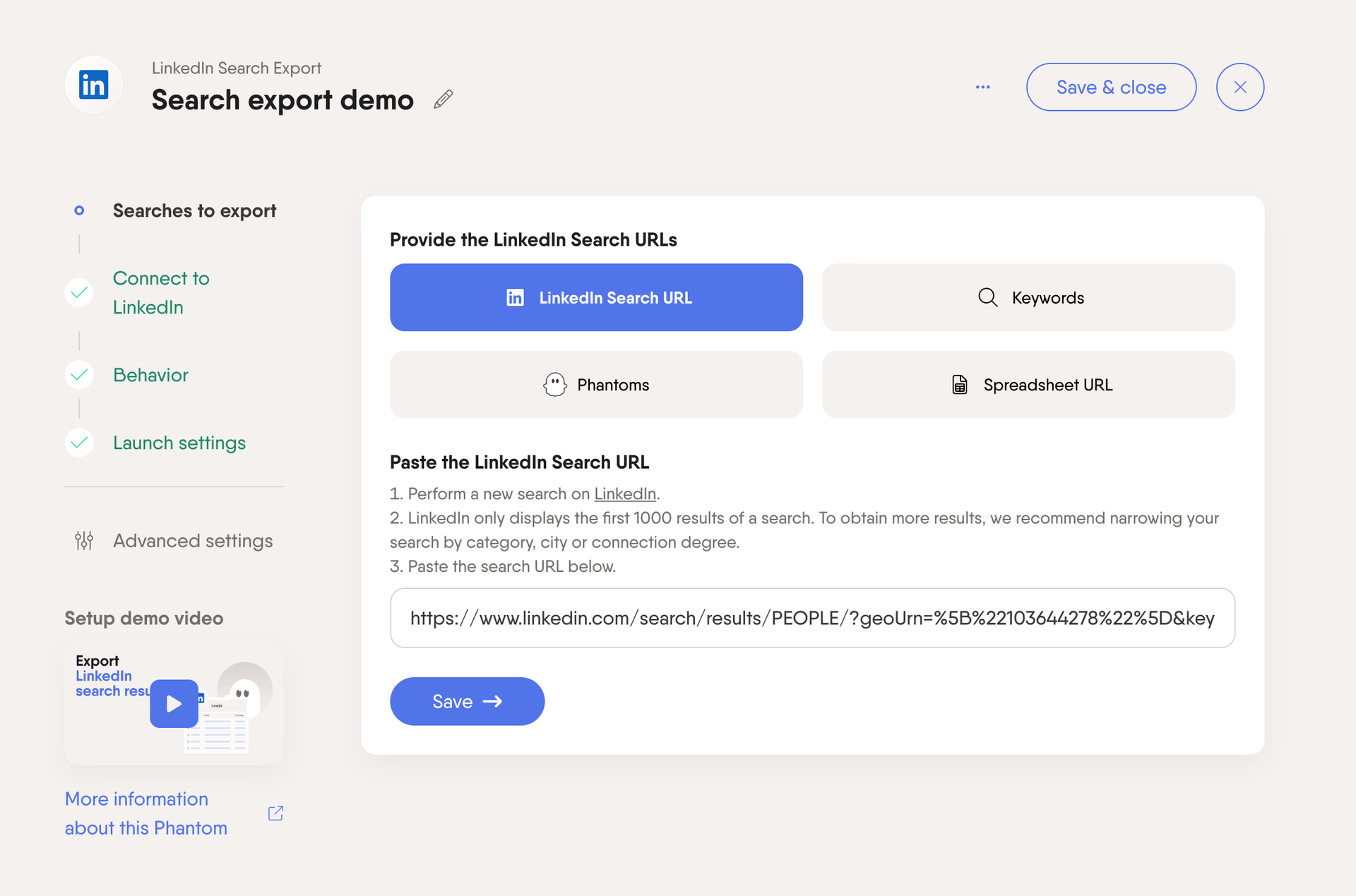
Creating targeted lead lists like this is essential for continuously feeding qualified leads in your pipeline, not just any leads.
It takes sales away from wasting time contacting prospects with a low conversion chance.
3. Enrich your lead database
Data enrichment is all about adding more details to your leads. This will help you prioritize large prospect lists into smaller targeted lead lists based on specific criteria.
You can extract intent data from LinkedIn, such as who liked an influencer post, or use AI to enrich your leads with a buying intent score generated based on existing data.
We recommend using PhantomBuster’s AI LinkedIn Profile Enricher Phantom to generate lead scores based on your data. Customize the AI prompt to calculate scores based on relevant criteria for your business.
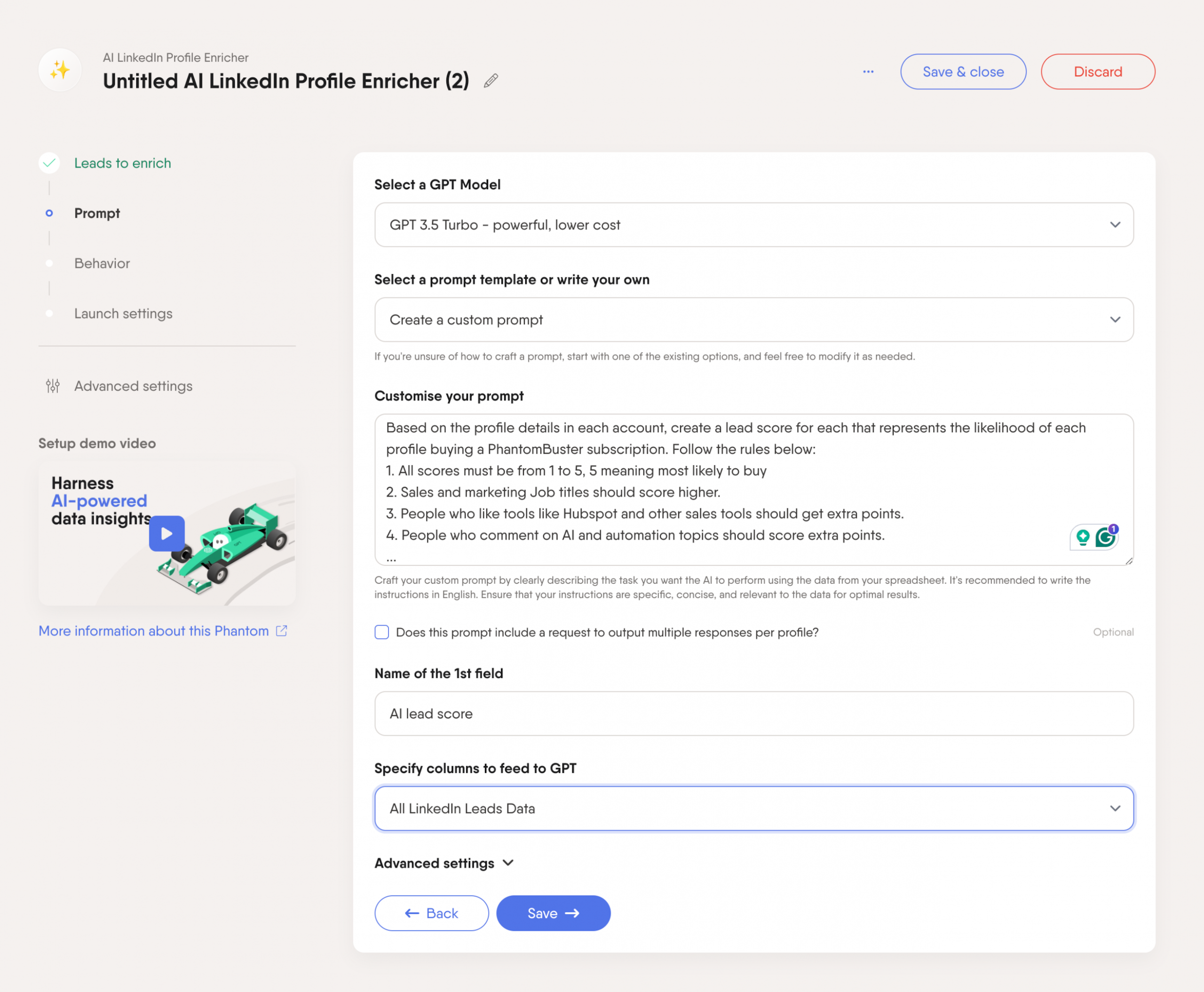
Then, use the AI lead scores to segment leads and identify the most promising ones.
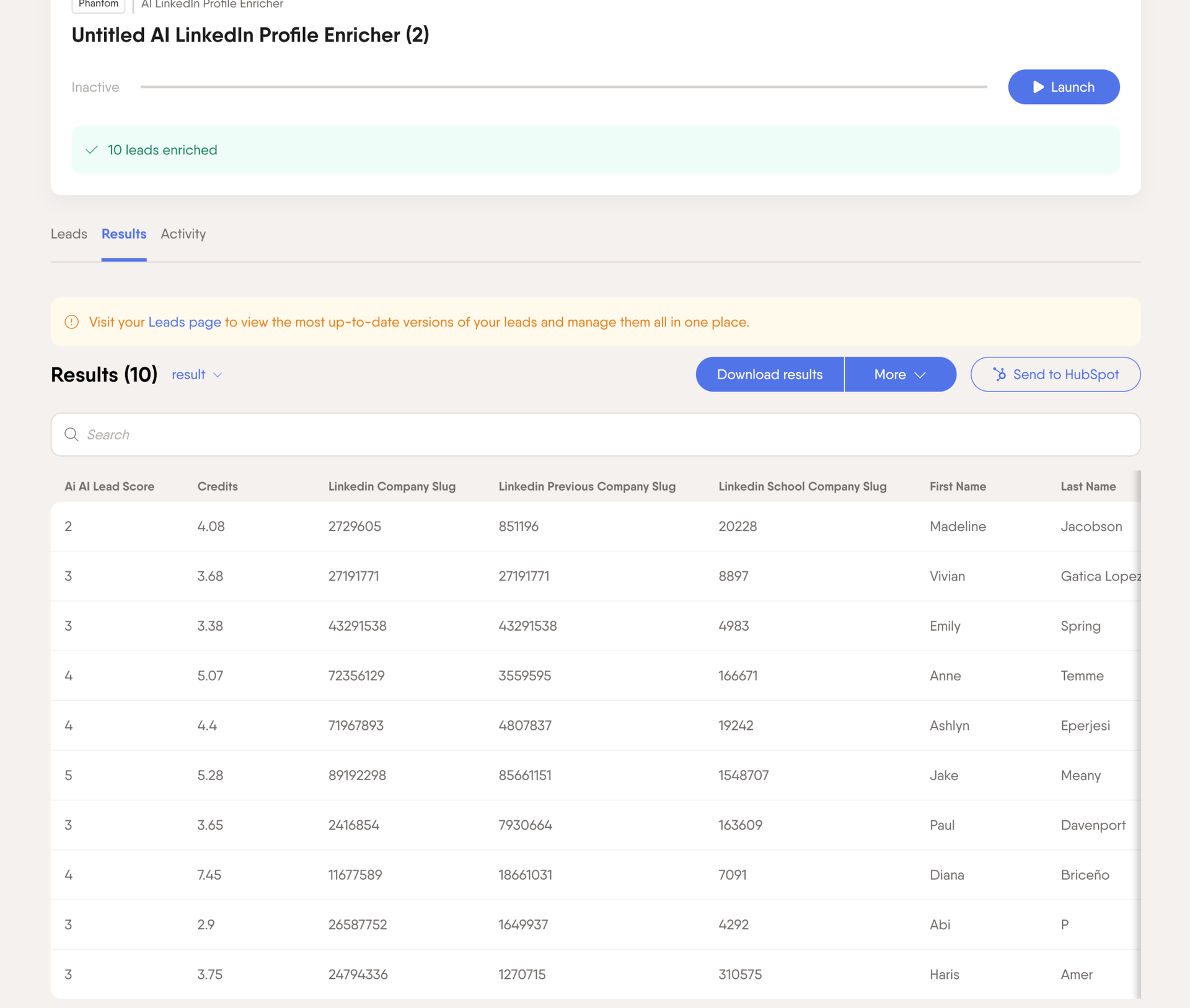
With extra details on each lead, you can then segment your lead list into small micro lists based on shared criteria. This will help you personalize your outreach and have a more targeted approach for better outcomes.
4. Segment audiences and create micro lists
You can use multiple criteria for customer segmentation.
For example, use intent signals, such as their recent social media interactions, or identify individuals who have switched jobs in the last month. You can further refine this by creating a new list that looks at previous and current employers to discover individuals who transitioned from Company X to Company Y.
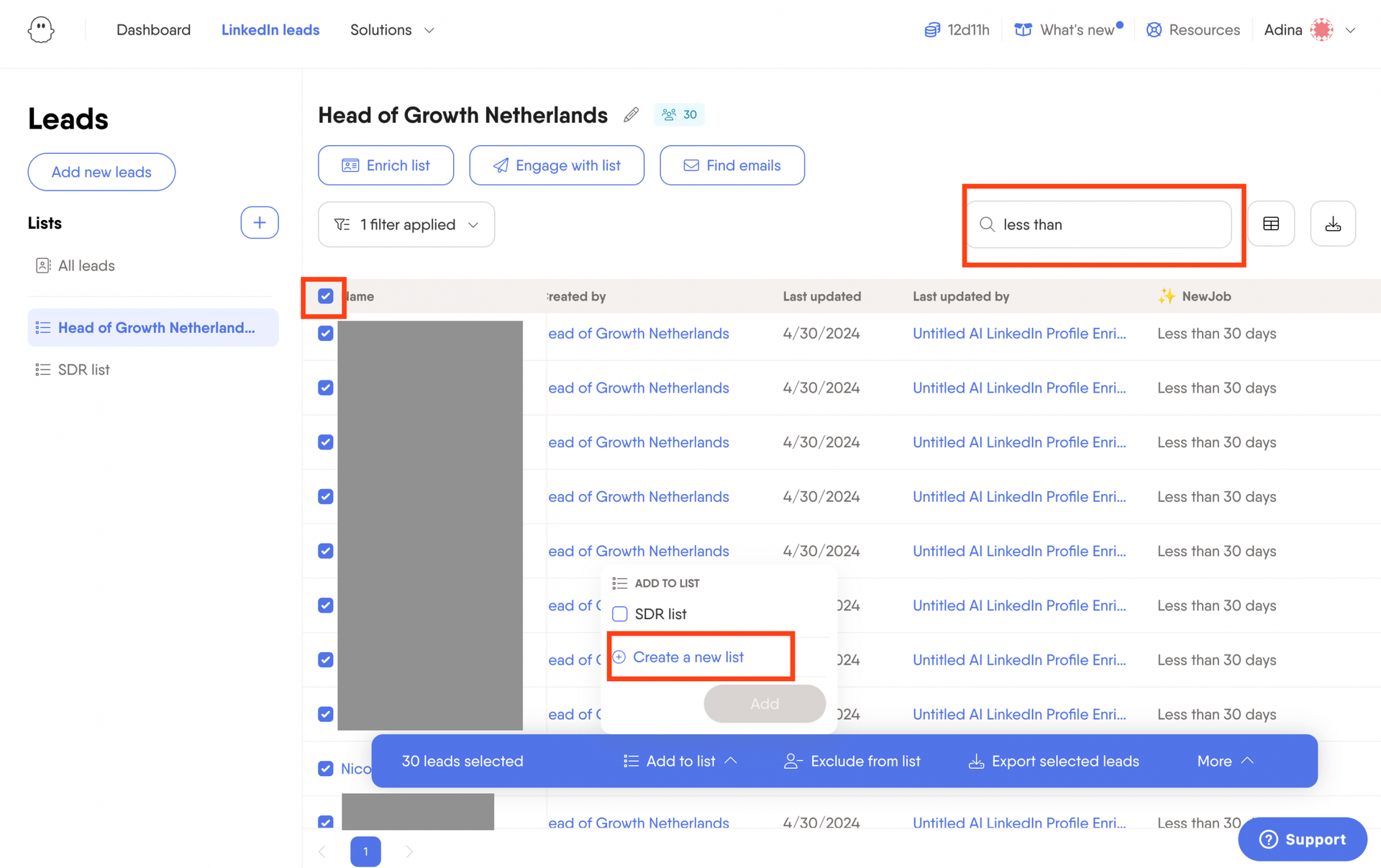
Your targeted leads look less like ‘marketing managers in Ohio’ and more like ‘marketing managers who have just changed jobs, liked our competitor’s post, and are attending an event about pharma sales.’
5. Sync data with your CRM and automate
For a process that works for every team, you need CRM integration to sync all these lead generation activities to a CRM so both marketing and sales teams have access to the same database of leads and work to keep it updated.
After all, you don’t want different people in your company reaching out to potential customers via different channels with different messages.

As we showed above, Using PhantomBuster for lead generation and enrichment will enable you to automatically sync the data into HubSpot.
As you nurture leads, the right trusted data matters.
So, put pipeline generation on auto-pilot. Start adding leads to your database and automating the process.
Let’s look at some of those methods.
Methods to generate targeted leads
Here are our recommended methods for generating targeted leads.
Use lead scraping tools for fresh quality leads
Data scraping from LinkedIn is a highly effective method of obtaining fresh, up-to-date information. You can create micro lists of highly targeted sales leads by focusing on intent signals.
Here are some examples (scroll to the end of the article for more details on how to use tools to create lists):
- Scrape LinkedIn event attendees: Attending a LinkedIn event typically shows that someone is interested in learning more or sharing their knowledge on the subject, making them serious, high-quality leads in most instances.
- Export LinkedIn company post likers: People engaging with a competitor or a product that integrates with your tool can be considered high-quality leads to include in your targeted lead generation process.
- Scrape LinkedIn influencer posts: People engaging with industry influencers are highly likely to be part of your target audience and be considered relevant targeted leads.
Use LinkedIn Sales Navigator and its advanced filters to create lists
LinkedIn Sales Navigator is a powerful tool for building targeted lead lists, offering a range of advanced filters that allow you to zero in on your ideal prospects.
With LinkedIn Sales Navigator, you can filter potential leads by various criteria, such as industry, company size, location, job title, and years of experience, using advanced search filters.
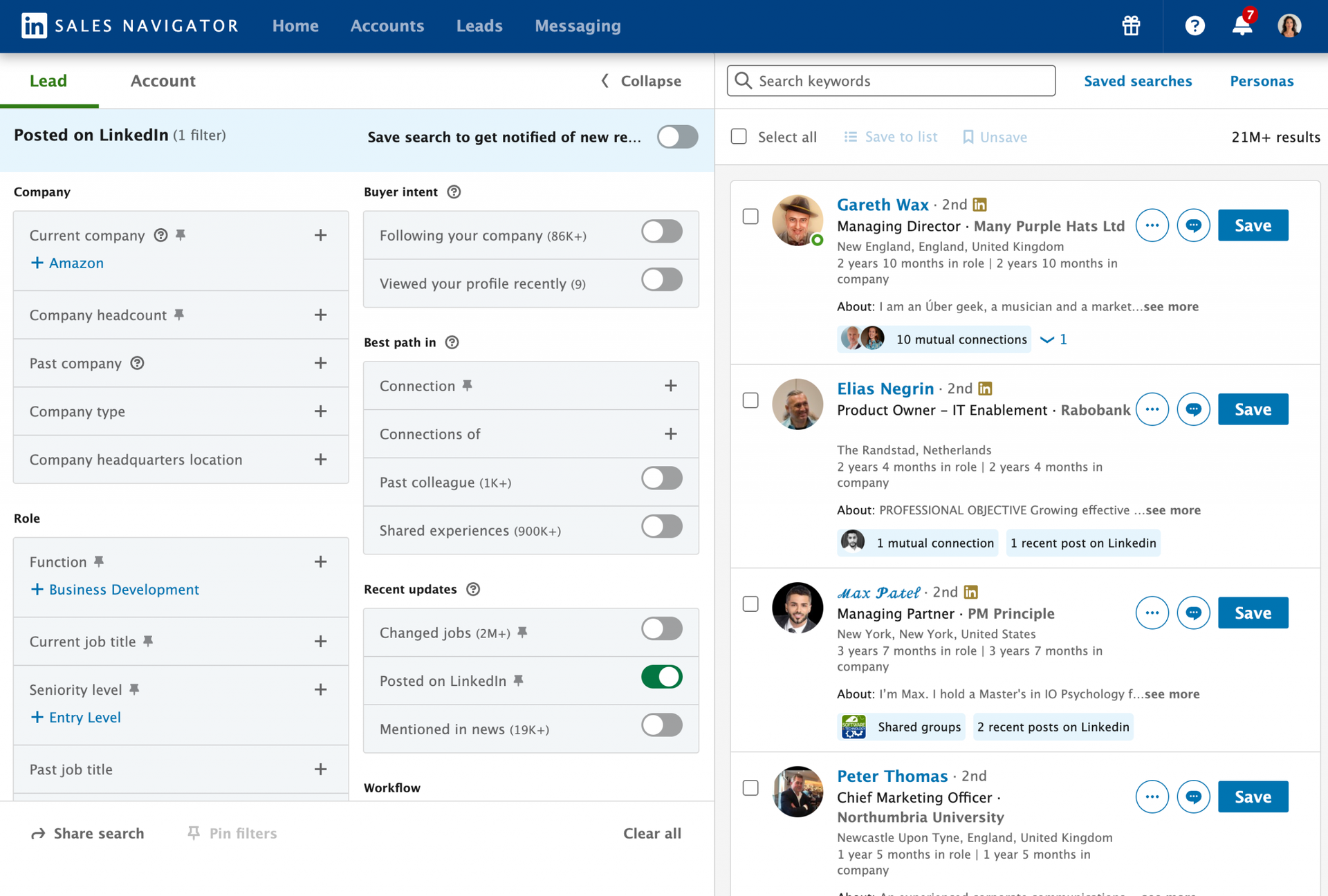
These filters enable you to narrow your search and find the most relevant, high-quality leads that align with your targeted lead generation strategy.
For example, if you’re targeting marketing managers in the technology sector, you can use these filters to create a list of professionals who fit these criteria.
You can also set alerts to stay updated when new leads are added to your list.
This feature ensures that you are always aware of changes within your target audience, such as when a prospect changes jobs or shares a new post.
These alerts help you maintain an up-to-date lead database and enable you to promptly engage with potential customers, keeping your lead generation process efficient and effective.
Buy lead lists (Not recommended)
Although an option, we don’t recommend using purchased lead lists. This can be risky because they often lack accuracy and may not comply with GDPR regulations.
If misused, you risk potential fines.
These lists also fail to target your Ideal Customer Profile (ICP) or include enriched, up-to-date data.
They generally rely on broad industry or job role information, which can quickly become outdated and jeopardize your business.
Relying on such lists might cause you to overlook important updates, such as changes in decision-making authority when someone moves to a different company or the fact that they are already engaging with a competitor.
On the other hand, LinkedIn users regularly update their data, which you can further enrich with details specifically relevant to your needs.
Actionable strategies for generating targeted business leads
Now that you know what targeted lead generation is, here are some actionable ways of using automation tools for generating leads on auto pilot.
1. Monitor competitors and scrape social media post engagement
Who wouldn’t want to see how competitors are doing online?
If you can conduct a competitor analysis to understand their strategy and see who likes and comments on their posts, you can instantly understand the product.
How to implement
Use the Scrape leads from LinkedIn Company Posts flow to monitor your Competitors’ LinkedIn Pages and extract leads who like or comment.
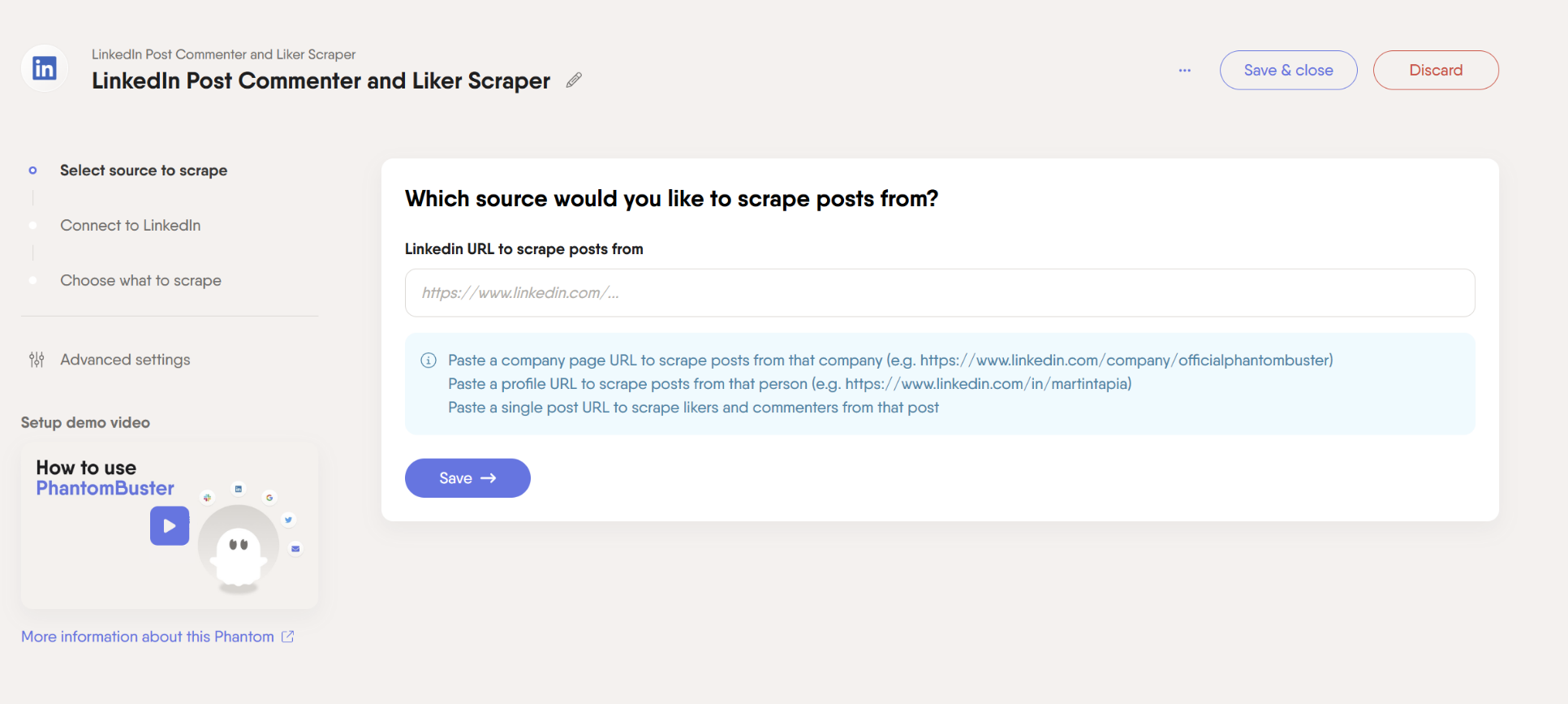
This will provide a broader understanding of industry engagement and opportunities for competitor analysis, for example.
2. Generate leads by scraping influencers’ LinkedIn profile posts
Let’s say you found a pack of influencers driving the conversation about your sector through influencer marketing.
You might be inspired by their content approach, want to work with and present them to your marketing team, or want to create relationships with them.
You need to start by scraping their content.
How to implement
1. Start by finding an influencer that’s relevant to your industry. Then, select a post that is relevant to your target audience and has engagement.
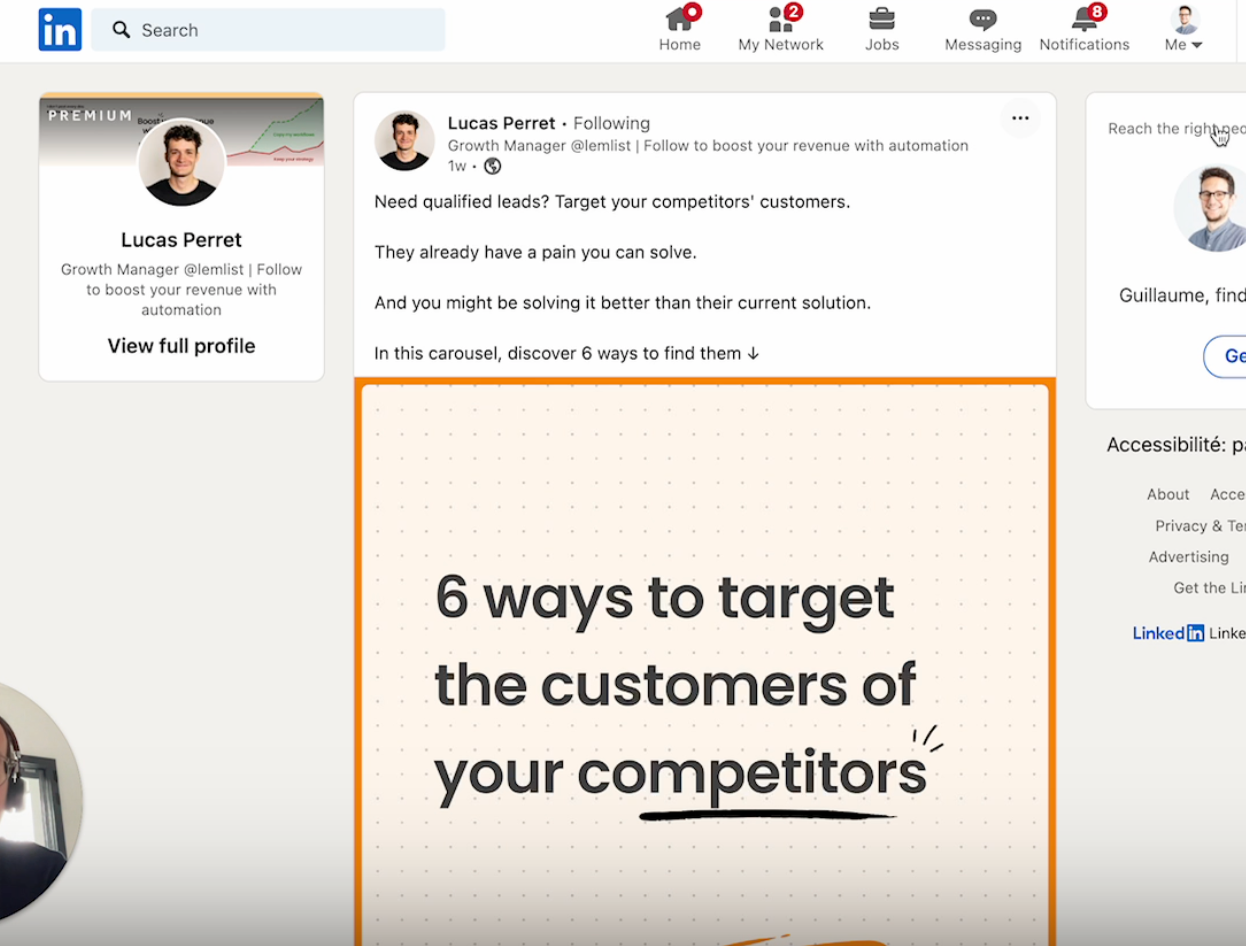
2. Copy the post URL and use it as input in the LinkedIn Profile Post Likers and Commenters Phantom.
3. Filter the list to exclude competitors.
Once you have your final list, you can use AI to generate personalized connection messages, automate outreach flows, and sync your data with HubSpot.
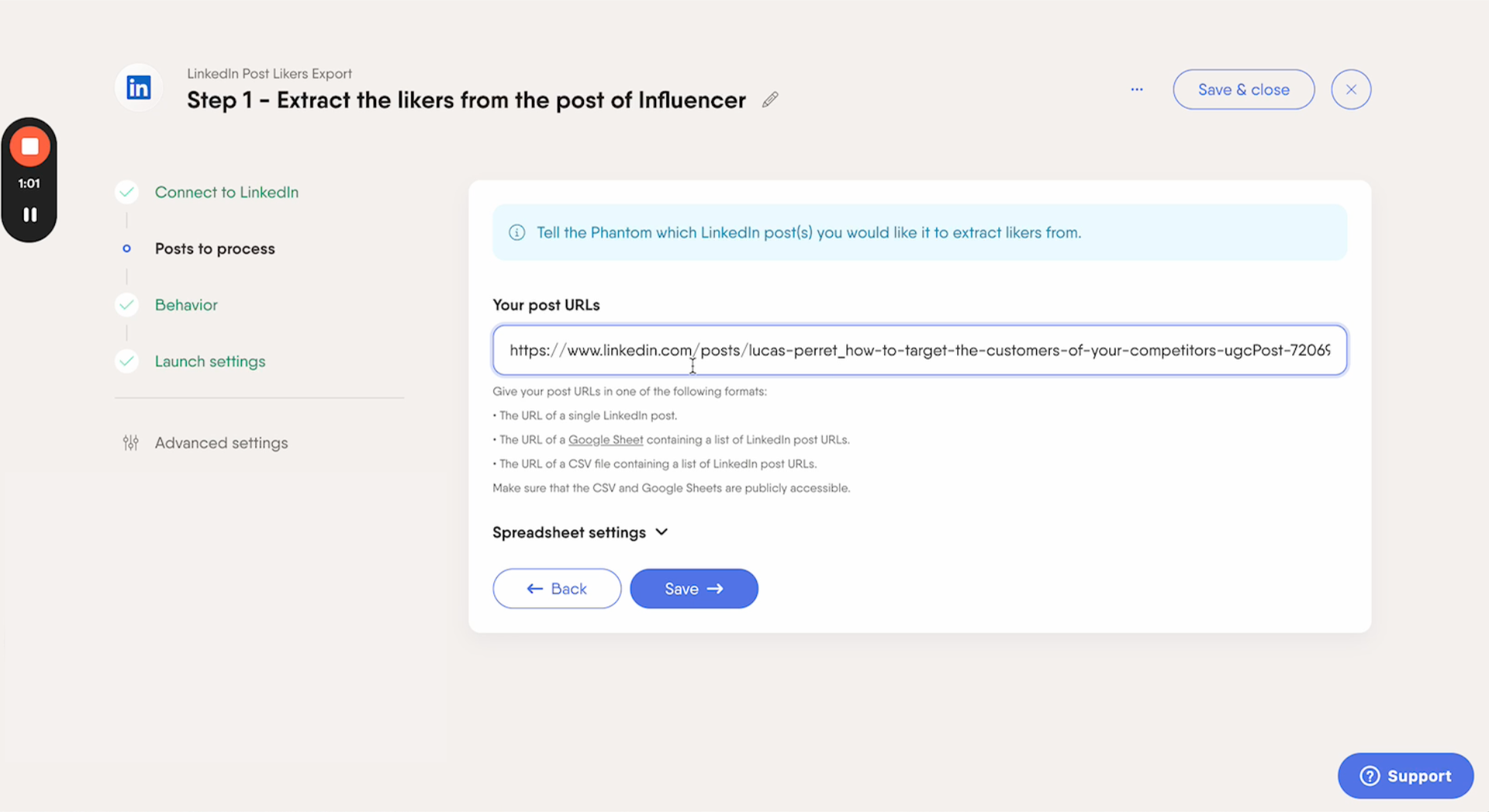
3. Scrape LinkedIn search results
What are people saying about you on LinkedIn? Who are your contacts connected with?
If you want to target your outreach with hidden gems and extra angles you may not have considered, one of your lead generation strategies should be using the LinkedIn Search Export Phantom.
You get all the data available on the LinkedIn search engine results page.
How to implement
- Install the browser extension for Chrome or Firefox to connect your session to the LinkedIn Search Export Phantom.
- Paste the URL of your LinkedIn searches.

- Set the number of results to scrape per search or launch, noting LinkedIn’s 1,000 result limit.
- Enable “Watcher mode” to continuously monitor for new results.
- Automate the process by scheduling repeated launches, even with your browser closed.
4. Export LinkedIn Group members
Did you know you can generate targeted leads on LinkedIn by performing a group members export of all the members of a LinkedIn group?
Export the latest 2,500 members of any LinkedIn group you’re a member of.
How to implement
- Launch the LinkedIn Group Members automation.
- Then, set it to process group members within safe limits (up to 2,500 per day), and ensure multiple launches throughout working hours for best results.
- For larger groups or groups you’re not part of, use LinkedIn’s Sales Navigator with custom searches based on the group’s ID to bypass the 2,500-member limit.
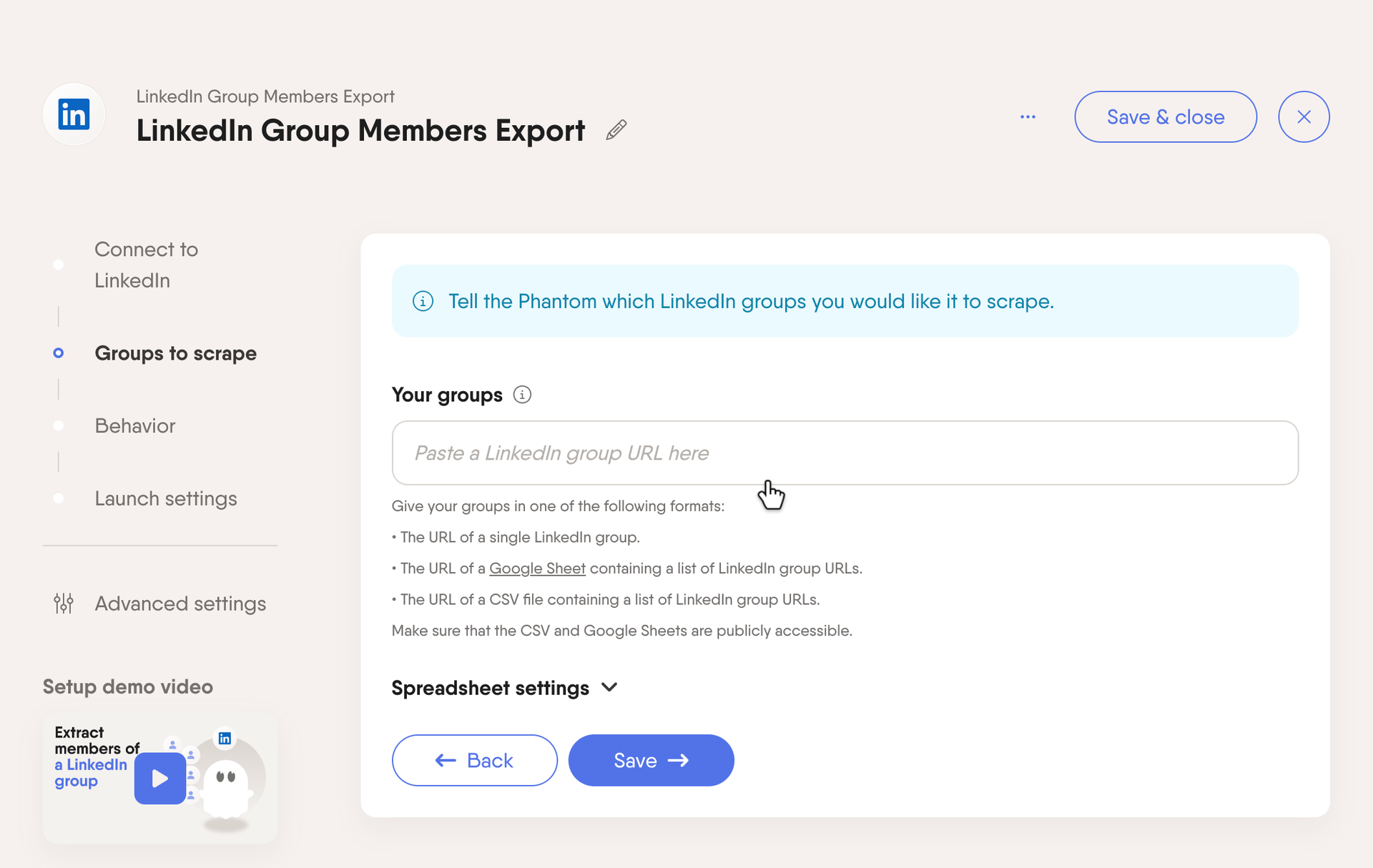
5. Scrape LinkedIn event attendees
Event attendees export is a powerful method to gather information from LinkedIn events. Whether it’s your event or an industry staple, a message to someone who attended an event is a great way to catch someone, making you feel instantly familiar.
Build rapport at scale by ensuring you have a sturdy list of event attendees.
You can enrich it or use it as it is with the LinkedIn profile URL, name, title, and location.
How to implement
- Launch the LinkedIn event attendees export automation.
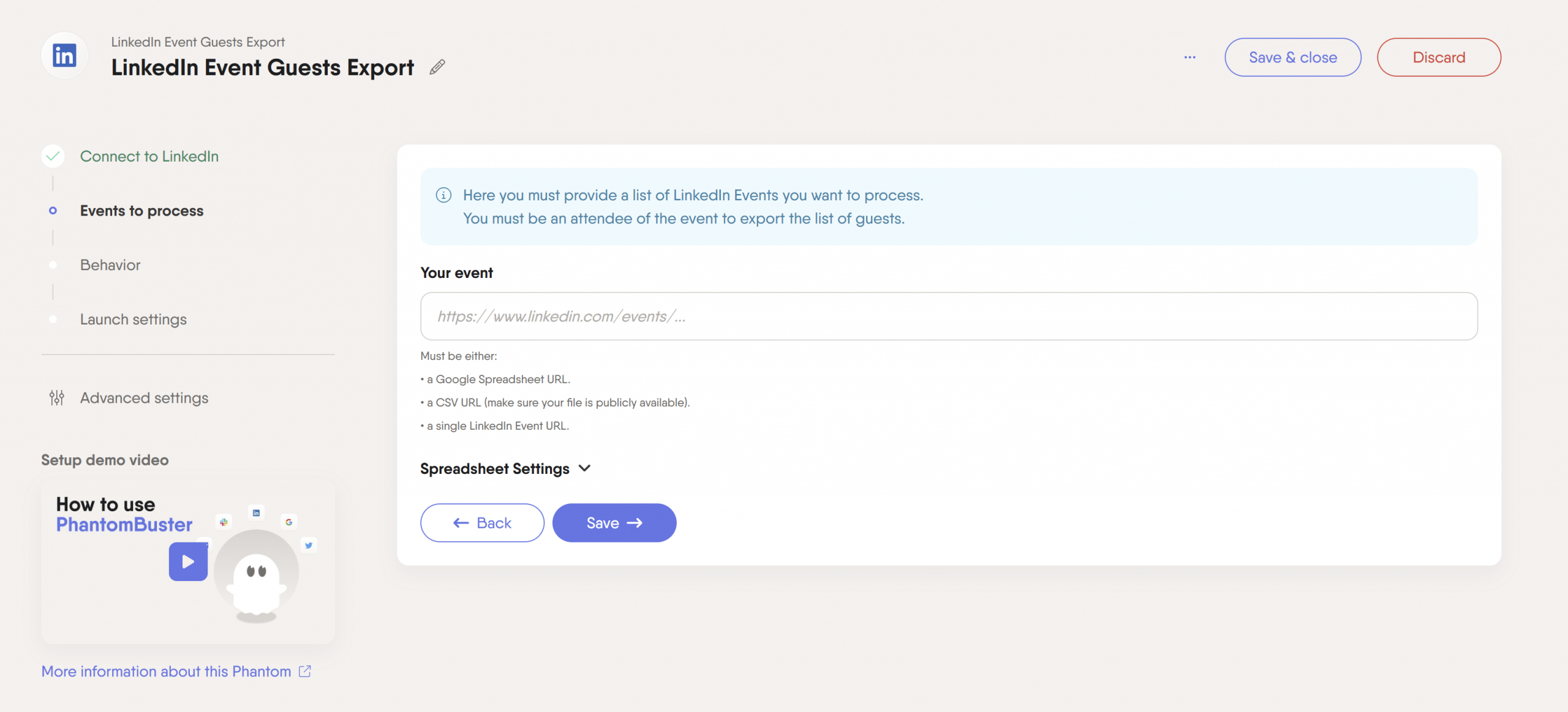
- If you only want to export attendees from oneevent, copy and paste the event URL.
- If you have multiple events to scrape, create a spreadsheet on Google Spreadsheet. Fill it with LinkedIn event URLs—one event URL per row, all in column A.
- Launch your Phantom. You can also choose to have it run repeatedly. View the results on your LinkedIn Leads page.
You’ll get a targeted lead list of all the attendees.
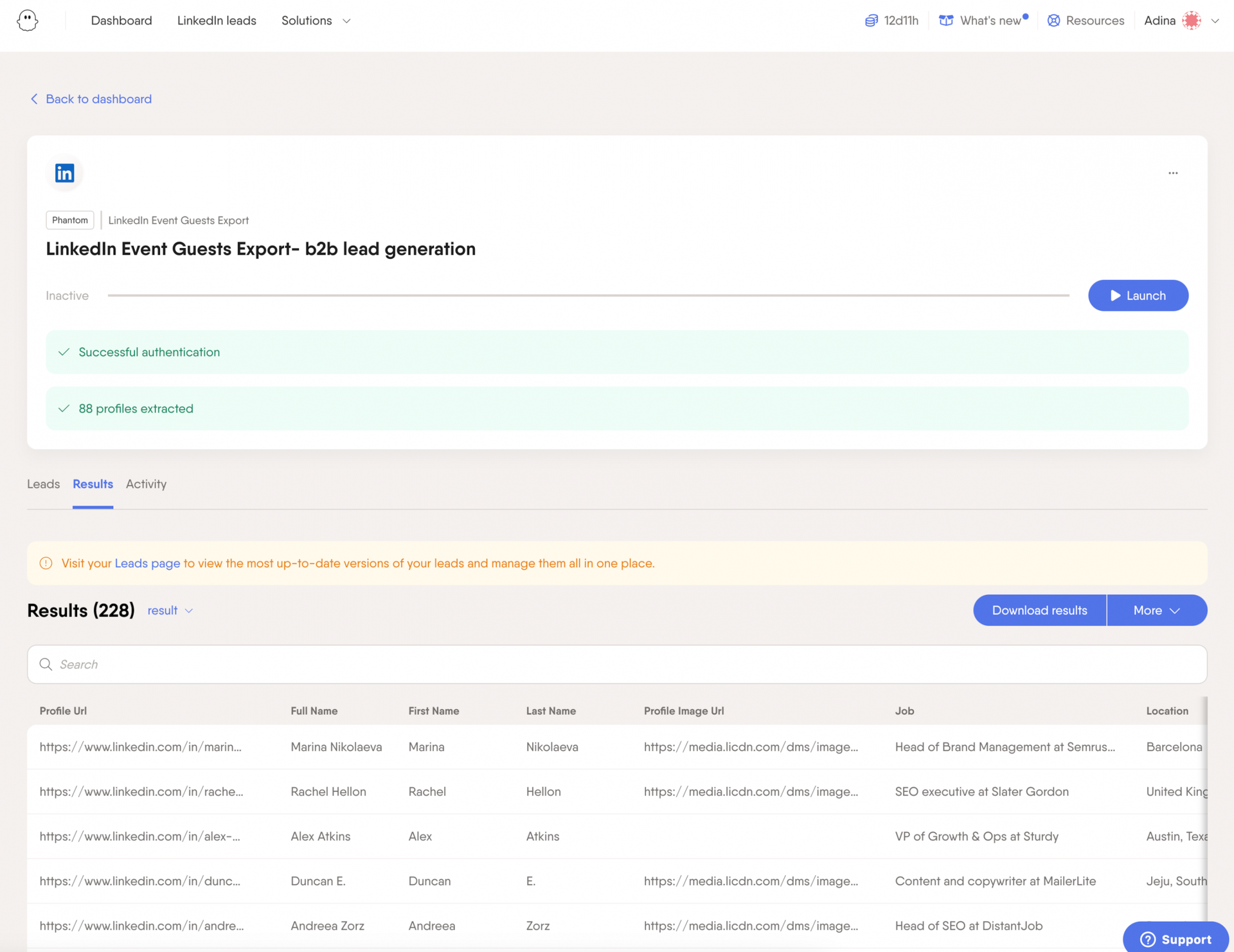
6. Inbound marketing lead generation
Inbound marketing is a strategic approach that maximizes lead generation from various channels as part of an effective inbound marketing strategy.
You’ll likely be undertaking some right now, and it’s a smart idea to focus on sales lead pipeline generation and inbound marketing activity to have the best coverage.
Additionally, the assets marketing teams create can further engage prospects and help move them through the sales funnel.
How to implement
- Lead Magnets: Offering free resources, such as eBooks or templates, in exchange for contact information to convert visitors into leads can be a great way to work together as sales and marketing teams
- Content Marketing (SEO): Creating blog posts, articles, and videos optimized for search engines to draw organic traffic is a great way to get started, and these links can be shared on LinkedIn, too.
- Paid Ads: While targeting ads on platforms like Google or social media to attract specific audiences can be expensive, it can draw in people looking for your competitors.
- Email Marketing: Nurturing leads through automated email sequences, providing relevant content to guide them through the sales funnel.
Lead generation tools
Leveraging lead-generation tools can significantly streamline and automate targeted lead generation. Especially when focusing on intent signals.
These tools enable you to extract and enrich data efficiently, making sure you reach the right audience with minimal effort.
Here are some of the top lead generation tools we recommend.
- PhantomBuster: For automating data extraction and enrichment from platforms like LinkedIn. It allows you to scrape data on potential leads, monitor competitor activity, and enrich profiles with additional insights, all while syncing seamlessly with your CRM.
- Clay: Known for its ability to automate data collection and enrichment, Clay helps you build comprehensive lead profiles by integrating various data sources, ensuring your sales team has a complete view of each prospect.
- Apollo: A robust platform that offers a comprehensive suite of tools for lead generation, including email outreach and CRM integration. Apollo’s advanced filtering options help you zero in on your ideal target audience.
- ZoomInfo: Provides access to a vast database of business contacts, allowing you to identify and reach decision-makers within your target market quickly. Its intent data capabilities help prioritize leads that are more likely to convert.
- Clearbit: Specializes in enriching your existing lead data with real-time intelligence. It offers insights into company size, industry, and more to help you better tailor your outreach efforts.
These tools can enhance your targeted lead generation strategy, making it more efficient and effective.
Measuring and optimizing your lead generation efforts
Measuring and optimizing your lead generation efforts is crucial to ensure that your targeted lead generation strategy is effective and efficient.
By tracking key metrics and using the right tools, you can identify areas for improvement and make data-driven decisions to optimize your lead generation process.
Key Metrics to Track
- Conversion Rate: The percentage of visitors who complete a desired action, such as filling out a form or purchasing. This metric helps you understand how well your lead generation efforts convert prospects into leads.
- Lead Volume: The number of leads generated within a specific time period. Tracking lead volume helps you gauge the overall effectiveness of your lead generation campaigns.
- Lead Quality: The percentage of qualified leads that meet your target audience criteria. High-quality leads are more likely to convert into customers, making this a critical metric.
- Cost per Lead (CPL): The cost of generating a single lead, including marketing and sales expenses. Monitoring CPL helps you manage your budget and ensure your lead generation efforts are cost-effective.
- Return on Investment (ROI): The revenue generated by leads compared to the cost of generating them. ROI provides a comprehensive view of the financial effectiveness of your lead generation strategy.
Conclusion
Targeted lead generation is a proactive sales prospecting technique where leads are sourced, enriched, and approached, creating a stronger sales pipeline than waiting for inbound leads!
However, a successful approach requires a clear process, including defining an Ideal Customer Profile (ICP), enriching and segmenting a lead database, and employing effective outreach tactics with the right tools by your side.
Are you ready to target leads?
Start a 14-day free trial, and see how Phantom Buster can help you attract potential customers and enhance your b2b lead generation efforts.
